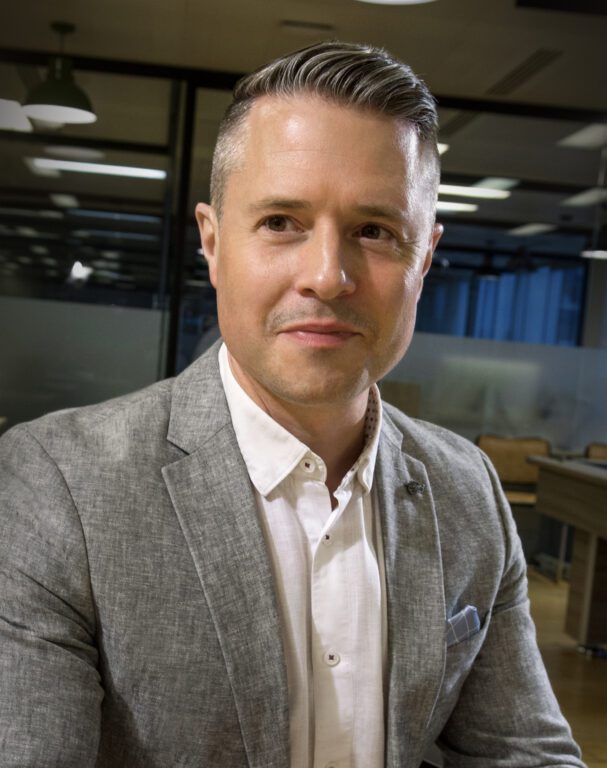
Iain Scott
CEO // Founding Partner
Iain has a strong background in digital, and brings high-level strategic thinking to client campaigns.

Iain Scott explains how the digital marketing flywheel model can be used to get non-clients to promote your services, winning you more work at a lower cost.
The digital marketing flywheel is a model which will help your business win more work by leading people through distinct phases, each with their own marketing activities and audience: the See stage, the Think stage, the Do stage and the Trust stage.
But the buyer journey isn’t always linear. People don’t always see your service, consider it against competitors, then decide to take action and become trusted clients. That’s where another vital part of the flywheel model comes in – it demonstrates how you can create promoters out of non-clients who will also win your business more work.
To take advantage of the digital marketing flywheel, you need to see it in action. The following example is designed to help you understand how the flywheel can be used by your organisation to increase its return on investment over time by creating promoters out of people who are not your clients.
Consider this example
Matt works at a large scale UK accounting firm, specialising in technology and software clients.
Many of Matt’s target audience don’t know that they can save a huge amount of tax when they correctly classify a portion of their resources towards research and development (R&D). Matt’s knowledge in this area is advanced, and in 90% of cases, he’s able to successfully assist his clients apply for tax credits, who receive thousands of pounds of tax relief.
Matt writes a short but compelling article on this topic, which he later posts on social media. The article ends with a link to a webinar his firm is hosting where Matt will further explore this easy way for technology firms to get tax relief by following this simple process.
Matt’s marketing team promotes the article and invests funds by paying a social media platform to promote it to key decision makers within technology firms outside their immediate network.
Caroline, department head of a mid-sized software company, sees the article in her feed, clicks to read it and subsequently signs up to hear Matt speak at the webinar.
Caroline later attends the website, during which she discovers that her firm may qualify for tax credits and, intrigued by this revelation, engages Matt in conversion after the talk in the hope of hiring him to save her company money.
Disappointingly, Matt is able to quickly determine that Caroline’s firm does not qualify for the tax relief. Caroline thanks Matt, asks him to send any further or regular information to her email. Then, they part ways.
Even though a sale hasn’t taken place, if you think back to the flywheel stages – See, Think, Do and Trust – you can safely determine the following things:
● Caroline was previously unaware of the tax relief that technology firms could gain from apportioning some of their resources to R&D. Matt’s talk brought awareness to a stranger, Caroline, about the availability of tax relief for technology firms.
● Upon considering options for her own technology firm, Caroline approached Matt to discuss using Matt’s services to assist her.
● Upon learning that an opportunity did not exist for Caroline’s firm, Caroline asks if she can be kept in the loop about any further tax saving opportunities. After this, Matt adds Caroline to his regular monthly email newsletter, filled with helpful information on tax credits, funds, and case studies on technology companies that have successfully saved money through Matt’s firm.
● Later, as Caroline begins to read Matt’s regular newsletters, trust is built in Matt and the services he provides
Caroline is not Matt’s client. But importantly, Caroline’s trust in Matt’s firm grows. She begins to trust in his services and believes that he could have a positive financial impact on her and possibly other technology firms.
Caroline’s request to be kept in touch is a positive action that would sit comfortably within the Do stage. In marketing, we often refer to these as secondary actions as they satisfy secondary objectives. If a primary objective is to convert a lead to a revenue generating client, secondary objectives and secondary actions involve signing up to an email newsletter, becoming a follower on social media, or bookmarking a website to refer back to at a more appropriate time.
Caroline has made her way around the flywheel.
See: She initially sees Matt’s talk and is introduced to something she was previously unaware of.
Think: She is then thinking about how Matt’s service could help her,
Do: She moved to the do stage to ask if Matt could help her, and (failing that) if she could be added to a newsletter to be kept informed of future opportunities.
Trust: Caroline regularly receives email newsletters that demonstrate how Matt’s firm continues to save his clients money, reinforcing her belief that Matt’s firm does a great job.
That’s all well and good – but there’s nothing in his story that Matt can take to the bank. If anything, Matt continues to spend money on his email marketing, giving away free advice for the benefit of people like Caroline.
However, what happens next will show you the power of the exceptional interaction, and why understanding the buyer journey as cyclical is a necessary aspect of successful integrated marketing in the 21st century.
Like many in her industry, Caroline runs a LinkedIn group for similar sized software companies. There, they share the latest industry trends and discuss topics including hiring, team and culture advice, financial planning, profitability and budgeting.
One of the group’s members, Lucy, opens a discussion thread on the topic of saving tax. She asks the group for advice on saving tax, available grants and sources of funding for early stage software development.
Caroline sees this and tells Lucy about her positive experience with Matt and his firm. Caroline immediately recommends Matt to the group, as well as forwarding on one of Matt’s emails to Lucy.
Lucy follows up with Matt to inquire if he can help and Matt confirms that Lucy’s startup software firm does qualify.
Lucy hires Matt’s firm, and within 3 months, Matt’s firm is able to save Lucy’s software company £50,000 in tax relief.
In the scenario above, two people from Matt’s audience group moved around the flywheel. Both trusted Matt and his firm. While Lucy inherited some of the trust from Caroline, this trust was consolidated through her interactions with Matt after Caroline had recommended Matt’s firm. Lucy also has her own experience with Matt, and is able to recite this to others, now with the added detail that Matt’s firm has directly helped hers.
The idea that existing clients recommend and refer others is not new. In fact, many industries rely solely on this.
What is crucial, however, is visualising the entire experience within the concept of a cyclical flywheel, and understanding how different marketing activities have varying degrees of force that all contribute to the momentum of the flywheel.
Knowing which forces are working and which to apply is the key aspect of a successful flywheel, and is crucial to making the concept of the exceptional interaction work for you.
Matt wasn’t successful in securing Lucy as a client because of chance or coincidence. Matt and his firm had carefully and strategically planned out every detail and every step of the audience journey, all within the flywheel model.
Matt’s marketing strategy and sales activity created a “free” sales force outside his own firm, made up of clients and non-clients.
Matt knew exactly which activity provided the flywheel with strong forces that contributed to its momentum, as well as lower force activity that leveraged the trust others had in him and his firm.
● Matt understood his audience well enough to know many were unaware of the tax they could be saving through R&D tax credits. This was vital in scripting the paid social media ads and articles that encouraged people to sign up to the webinar. Audience and message research is a key part of any marketing strategy.
● Matt also knew which professional social media sites his audience frequented and therefore where his firm’s ads should appear.
● Matt was fully aware what the content of his original webinar needed to include to incite and encourage beneficial outcomes and enquiries.
● He also spent time learning how to quickly qualify prospects who approached him after the webinar, to know if they fit the criteria to save tax, and if not, what secondary objectives and secondary actions he could suggest to prospects in that situation.
● With his marketing and content team, Matt had put in place regular content creation sessions that produced monthly newsletters filled with original, valuable and shareable information.
● Together with a set of reliable tracking and reporting tools, Matt was also able to measure the success of his activity at each stage of the flywheel, learning which activities to amplify and which to drop altogether.
Note that there was a much higher level of direct marketing spend acquiring Caroline as a newsletter subscriber than there was acquiring Lucy as a client.
The high force marketing activities (those often requiring a greater amount of time and money) give the flywheel momentum and move it around at speed. The lower force marketing activities (those often requiring less time and money) work well once the flywheel has already gained momentum.
Matt used a set of successful, measurable, integrated marketing activities to build his firm’s digital marketing flywheel.
If you want to build your marketing’s momentum and increase your return on investment, you need to understand how the flywheel can be applied to your organisation’s marketing activity.
That means mapping your marketing activity onto the flywheel, and beginning your journey building a trusting audience of willing promoters who will promote your work for free, provided you maintain their trust.
If you want us to put together a free flywheel for your company, don’t hesitate to reach out to us. You can learn more about the digital marketing marketing flywheel here.

CEO // Founding Partner
Iain has a strong background in digital, and brings high-level strategic thinking to client campaigns.
View my other articles and opinion pieces below
When were the first commercial solar panels installed? The noughties? The ‘90s? If you guessed the ‘80s, you’re half right… but half wrong. Boston-born inventor Charles Fritts installed the first solar array on a New York City rooftop in the 1880s. Fritts’s panels weren’t just a science experiment. They were a genuine attempt to commercialise […]

We see it all the time. Your company is spending money on a digital marketing campaign – Google Ads, social media, email marketing, SEO and more – but you just aren’t seeing the strong return on investment that you were promised. In this article, I will explain why the marketing model used by most businesses […]

In the early 1900s, Hollywood was making its mark as the home of moviemaking. Aspiring actors were flooding the streets, small studios were consolidating into industry giants, and the once small LA neighbourhood’s population was growing rapidly. By 1923, Los Angeles Times publisher Harry Chandler had funded the construction of a lavish residential development nearby. […]
